本试题 “短文改错假定英语课上老师要求同桌之间交换修改作文,请你修改你同桌写的以下作文。文中共有10处语言错误,每句中最多有两处。每处错误仅涉及一个单词的增加...” 主要考查您对不定冠词
物主代词
关系代词
形容词的比较级
副词
动词的第三人称单数
情态动词
限制性定语从句
there be句型
等考点的理解。关于这些考点您可以点击下面的选项卡查看详细档案。
- 不定冠词
- 物主代词
- 关系代词
- 形容词的比较级
- 副词
- 动词的第三人称单数
- 情态动词
- 限制性定语从句
- there be句型
不定冠词的概念:
冠词是置于名词前,说明各词所表示的人或事物的一种虚词,它不能离开名词而单独存在。冠词有两种,一种是定冠词,一种是不定冠词。定冠词是the,不定冠词有两种形式,一是a,另一是an。不定冠词a用于辅音音素起首的单词前,an用于元音音素起首的单词前。如:a bike, a dog, an egg, an elephant
不定冠词的特殊用法:
(1)用于序数词之前,表示数量或序数的增加:
如:Soon I saw a second plane.不久我又看到了另一架飞机。
"This is the second time that I've read the book." “这是我第二次看这本书。”
"Do you want to read it a third time?"“你还想看第三次吗?”
(2)用于表示“非常”、“很”等意义的most前:
如:This is a most interesting story. 这是一个非常有趣的故事。
(3)用于物质名词前,使之转化为具体名词,表示“一种”、“一杯之量”等:
如:A coffee, please. 请给我来杯咖啡。
I'd like a tea, please. 我要来杯茶。
(4)用于抽象名词前,使之具体化,表示与该之相关的具体的人或事:
如:He was a success in business. 他事业成功。
It's a pleasure to talk with you. 同你谈话是件令人愉快的事。
(5)用于指人的专有名词前,指某人、某人的作品或艺术品、…似(式)的人等:
如:A Mr Smith wants to see you. 一位名叫史密斯先生的人想见你。
He bought a complete Lu Hsun. 他买了一套鲁迅全集。
He thought he was a Zhu Geliang. 他自以为是诸葛亮。
(6)用于某些由动词转化来或具有动作意味的名词前,表示一次、一番等义(通常与have,take,make,give等动词连用):
如:Let's go out for a walk. 我们出去走走吧。
如:Do you care for as moke? 抽烟吗?
Would you like a drink? 要喝一杯吗?
(7)有的不可数名词或本来带有定冠词the的名词,由于受定语的修饰,其前可用不定冠词,表示某种状态。此时的不定冠词含有类似akindof的意思:
如:have breakfast 吃早餐─have a quick breakfast 吃快餐
the world 世界─a world like ours 像我们这样的世界
(8)构成短语表示数量:
如:a few apples 几个苹果
a little money 一点点钱
a lot of time 许多时间
a great many friends 许多朋友
不定冠词与one的用法解析:
1、两者均可表示“一”的意思,有时可互换。
如:About a[one] thousand students attended the meeting. 大约有1000学生参加了会议。
注:在数字开头时,两者均可用;但若不是数字开头,则应用one,如不可说three thousand a hundred,而说three thousand one hundred
如:A [One]Mr Smith wants to see you. 一个名叫史密斯先生的人想见你。(a Mr...与one Mr...同义,也可说a certain Mr...,但如果没有Mr这样的词,两者则不宜随便互换,否则含意会发生变化。
2、尽管两者均可表示“一”,有时也可换用,但毕竟由于两者的词性不同,用法不同,在多数情况下是不能互换的:
(1)从词性上看:a(an)是不定冠词,主要表示类别,即着重表示其后的名词是某物,而不是其他物;而one表示“一(个)”时是数词,主要表示数量,即强调在数量上是一个,而不是两个或多个。
比较:Give me a dictionary. 给我一本字典。
Give me one dictionary. 给我一本字典。
前者强调的是,我要的是一本字典,而不是一本教材,也不是一本小说等;而后者强调的是,我要的是一本字典,而不是两本字典或多本字典)。
再比较以下一组表达在意义上的区别:
more than a year一年多 (如一年零三个月等)
more than one year 不止一年 (如两年或三年等)
(2)由于one是数词,着重数量意义,所以当要强调数量、进行数量对比或回答how many的提问时,均应用one,而不能用a(an)。
如:He has only one pen, but I have two. 他只有一枝钢笔,但我有两枝。
I want one box, not five. 我想要一个盒子,不是要五个。
—How many friends do you have here? 你在这儿有多少个朋友?
—Only one. 只有一个。
(3)在某些表达中,两者均可用,但含义不同:at a time 每次,同时 at one time 一度,曾经 as a man 就一个人的性格而论 as one man一起,同时,全体一致地
在某些表达中,两者均可用,虽含义相同,但表达不同:
on a hot summe rafternoon 一个炎热的夏日的下午(注意用介词on)
one hot summer afternoon 一个炎热的夏日的下午(注意不用介词on)
an hour and a half一个半小时(通常不说one hour and a half)
one and a half hours 一个半小时
a minute or two一两分钟(通常不说one minute or two)
one or two minutes 一两分种
在绝大多数习语中,两者是不能换用的。如:
in a hurry 匆忙 once up on a time 从前 as a result 结果 all of a sudden突然 oneday 一天
one by one一个一个地 one and all 全部,每个人 one and the same 完全相同的
英语不定冠词(a/an)的用法:
1、用a还是an:一般说来,辅音或半元音[j, w]开头的词要前用a。
如:He has a computer (watch). 他有一台电脑(一块手表)。
He's a university student (European). 他是大学生(欧洲人)。
元音开头的词前要用an。
如:This is an egg (hones tboy). 这是一只鸡蛋(诚实的男孩)。
注意:有的字母(如a,e,f,h,i等) 或缩略词,若第一个音是元音也应用an。
如:He missed an "n" in the word. 他写的这个单词漏了一个n。
2、不要从汉语习惯出发,漏掉必用的a/an。
如:他父亲是著名诗人。
误:His father is famous poet.
正:His father is a famous poet.
3、用于转化为普通名词的专有名词前,表示某某人或某某人的一部作品、艺术品等。
如:A Mr Smith wants to see you. 一位叫史密斯先生的人想见你。
He bought a complete Lu Hsun. 他买了一套鲁迅全集。
4、用于转化为普通名词的物质名词前,表示相应的产品或种类,有时表示数量关系。
如:It’sagoodwine.这是(一种)好酒。 Twocoffeesandatea,please.请来两杯咖啡和一杯茶。
5、用于具体化的抽象名词前,表示与该抽象名词意义相关的人或事等。
如:The party was a great success. 晚会开得非常成功。
It's a pleasure to talk with you. 同你谈话是件愉快的事。
6、用于某些由动词转化来或具有动作意味的名词前,表示一次、一番等意义。
如:Let me have a look. 让我看看吧。
I'll give the car a good wash. 我要把车好好洗一洗。
7、用于序数词前表示数量或序数的增加。
如:He bought a second computer. 他又买了一台(即第二台)电脑。
Later she borne a third son. 后来她又生了第三个儿子。
8、有的不可数名词或本来应该带定冠词(the)的名词,由于受定语(尤其是形容词)的修饰,其前一般要用不定冠词或改用不定冠词,表示某种状态,此时的不定冠词通常含有a kind of的意思。
如:have breakfast 吃早餐→have a quick breakfast 吃快餐
the world 世界→a world like ours 像我们这样的世界
注:有些不可数名词即使受形容词的修饰也不能用不定冠词,容易弄错的有:news(消息),advice(忠告),luck(运气),fortune(运气),work(工作),fun(娱乐,有趣的事),weather(天气),homework(家庭作业),housework(家务活),information(情报),behavior(行为),harm(伤害),damage(损害),progress(进步),furniture(家具),baggage(行李),luggage(行李),poetry(诗),scenery(风景)等。
9、两个单数可数名词连用表示一个整体时,只用一个不定冠词。
如:He is a teacher and poet. 他既是老师又是诗人。
There's a horse and cart on the road. 路上有一辆马车。
10、不定冠词可用来表示“类属”,这是其基本用法,它表明的是某一类属中的每一个人和东西都能说明该类属的整体情况(有类似汉语的“举一反三”或“以此类推”的含义)。此时也可用定冠词或名词复数形式来表示。
如:马是有用的动物。
正:A horse is a useful animal.
正:The horse is a useful animal.
正:Horses are useful animals.
若不是说明每一个人和东西的情况,而是说整个类属,则不能用不定冠词,而要用定冠词。
如:The tiger is indanger of becoming extinct.老虎面临绝种的危险。
Alexander Graham Bell invented the telephone in 1876.亚历山大·格雷汉母·贝尔于1876年发明了电话。
不定冠词知识体系:
| 不定冠词 | a | 1、辅音音素开头的单词前用a,否则用an。 2、泛指,表“一个”但概念比one弱。 3、表类别 a+可数名词单数,不译为“一”。 4、表示单位,相当于“每”的意思。 5、用于序数词前,表“又一,再一”。 6、用于某些固定词组中,a lot of等。 |
| an |
使用不定冠词和不用不定冠词的差异:
1、英语中的某些名词即可用作不可数名词,又可用作可数名词,但是含义不同,用法也不一样。
如:iron 铁;an iron 一个熨斗
kindness 和善; a kindness 一件善事
2、“with+抽象名词”使用时相当于副词,抽象名词前不用不定冠词。
如:with pleasure 乐意地
with kindness 亲切地
with joy 高兴地
with diffculty 吃力地
with angry 生气地
但在“with+a+名词”结构中虽有不定冠词,却没有实际意义。
如:with a smile 微笑地
with an effort 努力地
with a light heart 愉快地
因汉语习惯用错不定冠词的几种情形:
(1)单数可数名词若泛指,其前需加a/an,不要按汉语习惯漏掉此不定冠词:
如:他是著名影星。
正:Heisafamousfilmstar.
误:Heisfamousfilmstar.
(2)不定冠词不能与指示代词、物主代词、所有格等连用:
如:我在公园遇到了我的一位朋友。
正:Imetafriendofmineinthepark.
误:Imetmyafriendinthepark.
(3)不要受汉语影响而用错不定冠词位置:
如:我从未读过如此有趣的书。
正:Ihaveneverreadsuchaninterestingbook.
误:Ihaveneverreadasuchinterestingbook.
误:Ihaveneverreadasointerestingbook.
不定冠词的省略与重复:
(1)在不引起误会的情况下,两个并列名词中的后一个名词前的不定冠词可以省略:
如:The noun is the name of a person or thing. 名词是人和物的名称。
(2)当两个并列名词指的是同一个人时,后一名词前的不定冠词通常省略:
如:His father is a teacher and poet. 他父亲是位教师兼诗人。
但如果要强调这两种身份,也可后一个不定冠词:
His father is a teacher and a poet. 他父亲既是教师,又是诗人。
有时,由于两个并列的名词关系比较紧密、被视为一个整体,也可只用一个冠词:
A man and woman are walking arm-in-arm.一对男女手挽着手走着。
(3)两个形容词并列同时修饰一个名词时,若该名词指的是两个事物,则通常应分别使用两个冠词:
如:We have a black and a white cat. 我们养了一只黑猫和一只白猫。
(比较:We have a black and white cat. 我们养了一只黑白花猫。)
但是,有时两个并列的名词只一个事物,为了加强语气,也有了两个冠词:
如:It was a cold and a dark night. 那是一个又冷又黑的夜晚。
(4)有些由两样东西构成的“自然成对”使用的事物,通常只在其前使用一个冠词:
如:a knife and fork一副刀叉
a cup and saucer 一副茶杯与茶托
a horse and cart 一辆马车
a needle and thread 一根带线的针
hire a car and driver 租一辆配有司机的汽车
有时连第一个冠词也省略(尤其是与介词连用时):
如:with knife and fork 用刀叉
(5)当要对两个并列的名词进行选择和比较方面的强调时,通常应重复两个冠词:
如:Give me a pen, not a pencil. 给我一支钢笔,不是铅笔。
Do you want a novel or a dictionary? 你是想要本小说,还是想要本字典?
物主代词的概念:
表示所有关系的代词叫物主代词。
物主代词有两种形式:一种是形容词性物主代词,在句中只能充当定语;另一种是名词性物主代词,和名词用法相同,在句中作主语、宾语、表语等。
物主代词的特性:
1、物主代词既有表示所属的作用又有指代作用。
例如:John had cut his finger;约翰割破了手指。
物主代词有形容词性(my,your等)和名词性(mine,yours等)两种,形容词性的物主代词属于限定词。
名词性的物主代词在用法上相当于省略了中心名词的“'s”属格结构,
如:Jack's cap 意为 The cap is Jack's.
His cap 意为 The cap is his.
2、名词性物主代词的句法功能:
a.作主语,例如:May I use your pen? Yours works better.
b.作宾语,例如:I love my motherland as much as you love yours.
c.作介词宾语,例如:Your should interpret what I said in my sense of the word,not in yours.
d.作主语补语,例如:The life I have is yours. It's yours. It's yours. 我的生命属于你,属于你,属于你。
物主代词的基本形式:
|
第一人称 |
第二人称 |
第三人称 | ||||
|
|
|
名词性 |
形容词性 |
名词性 |
形容词性 |
名词性 |
|
单数 |
my |
mine |
your |
yours |
his |
his |
|
复数 |
our |
ours |
your |
yours |
theirs | |
形容词性物主代词的用法:
1、形容词性物主代词通常修饰名词,作定语。
如:We should treat her mother very well.
2、与own连用表示强调。
如:I saw it with my own eyes.
名词性物主代词的用法:
1、名词性物主代词可作主语、表语和宾语。
如:This is my desk. Yours is over there.
2、名词性物主代词常用于双重属格,于of连用。
如:This girl is a friend of mine.
物主代词知识体系:
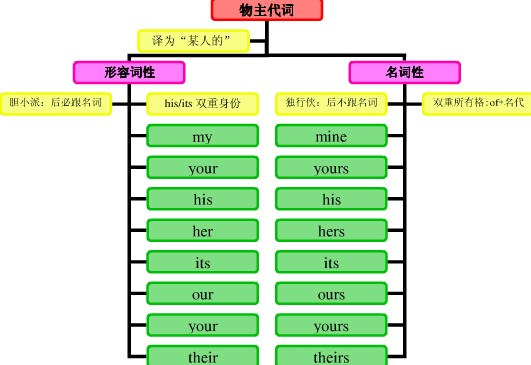
物主代词特别用法:
1、名词性和形容词性物主代词不能混用。
如:Jack has a low opinion of Sue.
2、物主代词的单复数必须和它所指代的名词一致。
如:His idea is to do more practice every day.
3、对于anyone,anybody,everyone,everybody,应根据上下文来判断his或her,有时也可用their。
如:Has everyone finished their work?
关系代词的概念:
英语中的关系代词有who, whom, whose, that, which, 它们是用来引导定语从句的。关系代词既代表定语从句所修饰的词,又在其所引导的从句中承担一个成分,如主语、宾语、表语、或定语。
如:This is the man who saved your son. (who在从句中作主语,先行词是man)
The man whom I met yesterday is Jim.
A child whose parents are dead is an orphan.
He wants a room whose window looks out over the sea.
关系代词用法:
1、that与which的用法区别:
两者都可指物,常可互换。其区别主要在于:
(1)引导非限制性定语从句时,通常要用which:
如:She received an invitation from her boss, which came as a surprise. 她收到了老板的邀请,这是她意想不到的。
(2)直接放在介词后作宾语时,通常要用which:
如:The tool with which he is working is called a hammer. 他干活用的那个工具叫做锤子。
(3)当先行词是下列不定代词或被它们修饰时much, little, none, all, few, every(thing), any(thing), no(thing)等时,通常用that:
如:There was little that the enemy could do but surrender. 敌人无法,只有投降了。
All[Everything] that can be done must be done. 凡能做的事都必须做。
(4)当先行词有the very, the only, the same等修饰时,通常用that:
如:This is the only example that I know. 我知道的例子只有这一个。
Those are the very words that he used. 那是他的原话。
(5)当先行词有形容词最高级或序数词(包括last, next等)等修饰时,通常用that:
如:This is the best dictionary that I've ever used. 这是我用过的最好的词典。
The first thing that you should do is to work out a plan. 你应该做的第一件事是订个计划。
(6)当关系代词在定语从句中用作表语时,通常用that:
如:China is not the country(that) it was. 中国已不是过去的中国了。
(7)当先行词是一个既指人又指物的并列词组时,通常用that:
如:They talked about the persons and things that most impressed them. 他们谈论了使他们印象最深的人和事。
(8)当要避免重复时:
如:Which is the course that we are to take? 我们选哪门课程?
2、that与who的用法区别:
(1)两者均可指人,有时可互换:
如:All that[who] heard him were delighted. 所有听了他讲话的人都很高兴。
Have you met anybody that[who] has been to Paris? 你遇见过到过巴黎的人吗?
He is the only one among us that[who] knows Russian. 他是我们中间唯一懂俄语的人。
(2)但是在下列情况,通常要用that:
①当先行词是一个既指人又指物的并列词组时:
如:I made a speech on the men and things that I had seen abroad. 我就我在国外所见到的人和事作了报告。
②当先行词是who时(为避免重复):
如:Who was it that won the World Cup in1982? 谁赢得了1982年的世界杯?
③当关系代词在定语从句中作表语时(可省略):
如:Tom is not the boy(that) he was. 汤姆这孩子已不是以前那个样子了。
关系代词知识体系:
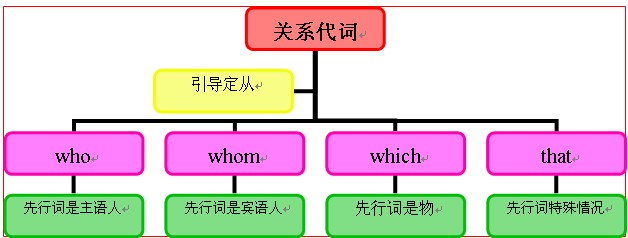
关系代词用法拓展:
1、as与which的用法区别:
(1)引导限制性定语从句时,在such,as,thesame后只能用as,其他情况用which:
如:I never heard such stories as he tells. 我从未听过他讲那样的故事。
It's the same story as I heard yesterday. 这故事跟我昨天听到的一样。
This is the photo which shows my house. 这张照片拍的是我的住宅。
(2)引导非限制性定语从句时,有时两者可互换:
如:I live a long way from work, as [which] you know. 我住得离工作单位很远,这你是知道的。
(3)但在,在以下情况引导非限制性定语从句时,两者不可换用:
①当从句位于主句前面时,只用as:
如:As is known to everybody, the moon travels round the earth once every month. 月球每月绕地球转一周,这是每个人都清楚的。
②as引导的非限制性定语从句应与主句在意义上和谐一致,which无此限制:
如:He went abroad, as[which] was expected. 他出国了,这是大家预料到的。
He went abroad, which was unexpected. 他出国了,这让大家感到很意外。(不用as)
③as引导非限制性定语从句时,先行词通常不能是主句中某个具体的词,而应是整个句子、整个短语或某个短语推断出来的概念,而which则无此限制:
如:The river, which flows through London, is called the Thames. 这条流经伦敦的河叫泰晤士河。(不用as)
④当as引导非限制性定语从句作主语时,其谓语通常应是连系动词,而不宜是其他动词,而which则无此限制:
如:She has married again, as[which] seemed natural. 她又结婚了,这似乎很自常。
She has married again, which delighted us.她又结婚了,这使我们很高兴。(不用as)
2、who与whom的用法区别:
两者均只用于人,从理论上说,who为主格,whom为宾格:
如:Where's the girl who sells the tickets? 卖票的女孩在哪里?
The author whom you criticized in your view has written a letter in reply. 你在评论中批评的那个作者已写了一封回信。
但实际上,除非在正式文体中,宾格关系代词whom往往省略不用,或用who或that代之:
如:The man(that, who, whom) you met just now is called Jim. 你刚遇见的那个人叫吉姆。
不过,在以下几种情况值得注意:
(1)直接跟在介词后面作宾语时,只能用whom,而且不能省略:
如:She brought with her three friends, none of whom I had ever met before. 她带了3个朋友来,我以前都没见过。
(2)引导非限制性定语从句且作宾语时,who和whom均可用,但以用whom为佳,此时也不能省略:
如:This is Jack, who[whom] you haven't met before. 这是杰克,你以前没见过。
形容词比较级概念:
大多数形容词(性质形容词)有比较级,用来表示两个人或事物之间的比较“较……”。
如:I am taller than you.
形容词比较级特殊用法:
1、没有比较对象的比较结构:
所谓没有比较对象的比较结构不是指省略而言,而是指并非真正的比较。
例如:The car runs faster than110 miles. 那辆车时速为110多英里。
There is more than one solution to the problem. 这个问题的解决办法不止一个。
The daily cost in an average hospital in the United States can run as high as $250. 在美国普通医院的每天的费用可高达250美元。
2、用比较级的形式表达最高级的意思:
在这种情况下,往往是将一个人或是一件事与其他所有的人或事相比较。注意别忘了常在比较状语中用any, other, else类的字眼,以将比较主体排除在比较对象以外,因为自己不可以与自己相比较。
例如:He is taller than any one else in our class. 他在我们班比其他任何都高。
Iron is more useful than any other metals. 铁比其他任何金属更有作用。
3、no+比较级+than的结构表示“A和B一样不……”:
例如:She runs no faster than her sister.她与她妹妹一样跑不快。
Tom is no wiser than John. 汤姆和约翰一样没有聪明才智。
He is no richer than his brother. 他与他弟弟一样不富有。
4、汉语可以说“昆明的气候比兰州好”。英语必须加that:
例如:The climate of Kunming is better than that of Lanzhou.
5、英语比较级常译作“较…”、“…一些”等,但不等于汉语的“更…”。汉语的“更…”须用“still”或“even”来表示:
如:This book is even more difficult than that one. 这本书比那本书更难。
6、有些情况下,汉语不用“较”等字眼,英语则须用比较级:
如:Will the younger people give their seats to old people? 请年轻人把座位让给老年人好不好?
形容词比较级的用法:
1、比较级用于二者的比较,其结构是:含有形容词比较级的主句+从属连词than引导的从句(从句中常省去意义上和主句相同的部分)。
如:Li is older than Zhou. 李比周年纪大。(从句中省去了is old)
There are more children in this nursey than in that one. 这个托儿所的孩子比那个托儿所多。(从句中省去了there are children)
After two years' physical training, she is healthier and stronger. 经过两年的体力锻炼,她(比以前)健康强壮多了。(注意这里省去了从句than she was)
We are much better off than ever before. 我们的生活比过去任何时候都要好得多。(than后省去了we were)
Paul weighs less than harry. 保尔的体重比哈利轻。
Mary is less clever than Jane. 玛丽不如简那么聪明。
2、可修饰比较级的词:
1)a bit, a little, rather, much, far, by far, many, a lot, lots, a great deal, any, still, even等
2)还可以用表示倍数的词或度量名词作修饰语。
3)以上词(除by far)外,必须置于比较级形容词或副词的前面。
典型例题:
1)—Are you feeling ____?
—Yes,I'm fine now.
A. any well
B. any better
C. quite good
D. quite better
答案:B. any可修饰比较级,quite修饰原级,well的比较级为better.
2)The experiment was____easier than we had expected.
A. more
B. muchmore
C. much
D. moremuch
答案:C. much可修饰比较级,因此B,C都说得通,但easier本身已是比较级,不需more,因此C为正确答案。
3)If there were no examinations, we should have___at school.
A. the happiest time
B. a more happier time
C. much happiest time
D. a much happier time
答案:D.
注:many, old和far用法:
1)如果后接名词时,much more+不可数名词 many more+可数名词复数
2)old有两种比较级和最高级形式:older/oldest和elder/eldest。elder,eldest只用于兄弟姐妹的长幼关系。
如:My elder brother is an engineer.
3)far有两种比较级,farther,further在英语中两者都可指距离。在美语中,father表示距离,further表示进一步。
如:I have nothing further to say.
3、比较级中的两个特殊作用的结构:
1)The+比较级+句子,表示的意义是“越(怎么样就)越(怎么样)”,在这个结构中的两个“比较级”不要求一定词性相同,它们各自的词性要依句子的需要而定;
2)和比较级+and+比较级。表示的意义是“越来越(怎么样)”,在这个结构中的两个“比较级”则要求词性相同。
例如:The harder you work at your study, the better academicrecords you will have. 你学习越努力,你的成绩就越好。
The more we have, the more we want. 人欲无穷。
When winter is coming, it gets colder and colder. 冬天来临之际,天越来越冷了。
He became less and less satisfied with the foot ball team's performance. 他对足球队的表现越来越不满意了。
形容词比较等级知识体系:
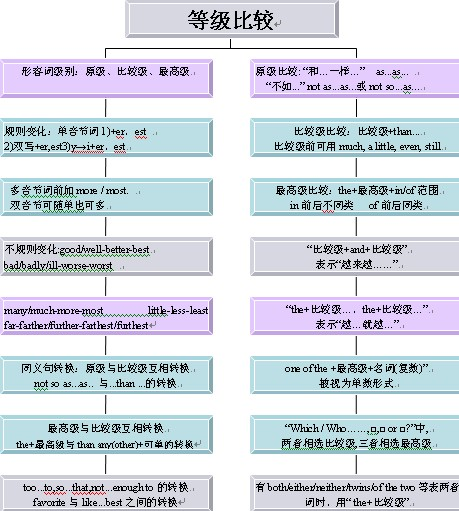
特殊形容词比较级变化:
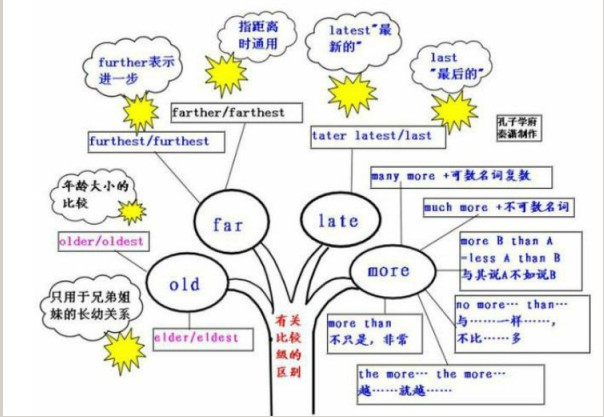
副词的概念:
副词是指在句子中表示行为或状态特征的词,用来修饰动词、形容词、其他副词、介词短语、非谓语动词乃至整个句子,表示时间、地点、程度、方式等概念。
副词的位置:
1)在动词之前。
2)在be动词、助动词之后。
3)多个助动词时,副词一般放在第一个助动词后。
注意:
a. 大多数方式副词位于句尾,但宾语过长,副词可以提前,以使句子平衡。
如:We could see very clearly a strange light ahead of us.
b. 方式副词well,badly糟、坏,hard等只放在句尾。
如:He speaks English well.
副词的排列顺序:
1)时间,地点副词,小单位的在前,大单位在后。
2)方式副词,短的在前,长的在后,并用and或but等连词连接。
如:Please write slowly and carefully.
3)多个不同副词排列:程度+地点+方式+时间副词。
注意:副词very可以修饰形容词,但不能修饰动词。
改错:(错)I very like English.
(对)I like English very much.
注意:副词enough要放在形容词的后面,形容词enough放在名词前后都可。
如:I don't know him well enough.
There is enough food for everyone to eat.
There is food enough for everyone to eat.
兼有两种形式的副词:
1)close与closely:
close意思是“近”;closely意思是“仔细地”。
如: He is sitting close to me.
Watch him closely.
2)late与lately:
late意思是"晚";lately意思是“最近” 。
如:You have come too late.
What have you been doing lately?
3)deep与deeply:
deep意思是“深”,表示空间深度;deeply时常表示感情上的深度,“深深地” 。
如:He pushed the stick deep into the mud.
Even father was deeply moved by the film.
4)high与highly:
high表示空间高度;highly表示程度,相当于much。
如:The plane was flying high.
I think highly of your opinion.
5)wide与widely:
wide表示空间宽度;widely意思是“广泛地”,“在许多地方”。
如:He opened the door wide.
English is widely used in the world.
6)free与freely:
free的意思是“免费”;freely的意思是“无限制地”。
如:You can eat free in my restaurant whenever you like.
You may speak freely, say what you like.
副词知识体系:

动词第三人称单数的概念:
在一般现在时中,当主语是第三人称单数时,谓语动词要用第三人称单数形式,即常在动词原形后加-s或-es。
动词第三人称单数的变化规则:
在一般现在时的句子中,当主语是第三人称单数时,动词要发生变化。
一般现在时的肯定句中,主语为第三人称单数的动词变化主要体现在词尾的变化上,其规律大体有三点:
1、一般情况下,直接在动词词尾+s,例如:get→gets; take→takes
2、以s, sh, ch, x, o结尾的动词,在词尾+es,例如:teach→teaches; fix→fixes; go→goes
3、以辅音字母+y结尾的动词,变y为i,再+es,如:study→studies; try→tries
除上述规律外,还应注意下面三点:
1、动词have,遇到主语是第三人称单数时,要用has;动词be的第三人称单数形式是is。
2、含有动词第三人称单数形式的句子变否定句时,要用doesn't+动词原形:
如:He goes to school at six in the morning.(变否定句)
→Hedoesn'tgotoschoolatsixinthemorning.
3、对含有动词第三人称单数形式的句子提问时,要用助动词does:
如:She goes home at five every day.(对划线部分提问)
→When/What time does she go home every day?
综上所述,只要我们洞悉了英语动词第三人称单数形式的变化规则,在一般现在时的句子中,我们都能从容应对,客随主“变”了。
动词第三人称单数的用法:
在一般现在时中,当主语是第三人称单数时,谓语动词要用第三人称单数形式,即常在动词原形后加-s或-es。现归纳总结如下:
一、人称代词he, she, it是第三人称单数。
如:He likes watching TV. 他喜欢看电视。
She has lunch at twelve. 她十二点吃午餐。
It looks like a cat. 它看起来像只猫。
二、单个人名、地名或称呼作主语;是第三人称单数。
如:①HanMei looks like her mother. 韩梅看起来像她的母亲。
②Beijing is in China. 北京在中国。
③UncleWang often makes cakes. 王叔叔经常做蛋糕。
三、单数可数名词或"this/that/the+单数可数名词"作主语时,是第三人称单数。
如:①A horse is a useful animal.马是有用的动物。
②This book is yours.这本书是你的。
③That car is red.那辆小汽车是红色的。
④The cat is Lucy's.这只猫是露茜的。
四、不定代词someone, somebody, nobody, everything, something等及指示代词this, that作主语时,是第三人称单数。
如:①Everyone is here.大家到齐了。
②There is something wrong with the watch.这块手表有毛病。
③This is a pen.这是一支钢笔。
④That is an eraser.那是一块橡皮擦。
五、不可数名词作主语时为第三人称单数。
如:①The milk is in the glass.牛奶在玻璃杯里。
②The bread is very small.那面包很小。
六、当数字或字母作主语时,看作第三人称单数。
如:①"6" is a lucky number. "6"是个吉利数字。
②"I" is a letter. "I"是个字母。
情态动词的概念:
情态动词表示说话人对某一动作或状态的态度。
几组词的辨析:
1、need和dare的用法:
need和dare既可用作情态动词,也可用作实义动词。用作情态动词时,主要用于否定句和疑问句。用作实义动词时,可用于各种句式。
(1)用作情态动词:
如:—Need I come? 我需要来吗?
—Yes, you must. 需要。
You needn′t telephone him now. 你现在不必打电话给他。
I don′t think you need worry. 我想你不必发愁。
She dare not go out alone at night. 她晚上不敢一个人出去。
How dare you say I′m unfair? 你竟敢说我不公平?
Not one of them dared mention this.他们谁也不敢提这件事。
(2)用作实义动词:
如:You don′t need to do it yourself. 你不必亲自做这件事。
We need to tell them the news. 我们需要把这消息告诉他们。
The table needs painting(to be painted.). 桌子需要油漆一下。
We should dare to give our own opinion.我们要敢于提出自己的观点。
He did not dare(to) look up. 他不敢抬头看。
I dare day he′ll come again. 我想他会再来的。
2、can和be able to:
(1)情态动词can只有两种时态形式,现在式can和过去式could,而be able to有多种时态形式。
如:Mary can play the piano. She has been able to play it since she was 5. 玛丽会弹钢琴。她五岁起就会弹了。
(2)用在过去时中,could经常表示能够做某事,事实上不一定去做,而was∕were able to则表示“过去做成了某事”。在否定句中两者可通用。
如:He could swim across the English Channel. But he didn′t feel like it that day.
他能游过英吉利海峡,但那天他不想游。
Yesterday I was able to get home before the heavy rain. 昨天我在下大雨前赶到了家里。
3、must和have to:
must表示主观意志,而have to表示由于客观因素不得不做某事。must没有过去式,除在间接引语中可用于表示过去时间,在直接引语中表示过去时间应该用had to代替。
如:I told her that she must give up smoking. 我叫她必须戒烟。
We had to get everything ready that night. 我们那晚得把一切准备就绪。
4、would和used to:
(1)usedto表示过去与现在或过去某时与后来的情况有不同,而would只表过去的情况。
如:People used to think that the earth was flat. 过去人们认为地球是平的。(现在人们不这么认为。)
She would go out for a walk in the morning when she was in the country.
在乡下时,她总是在早晨去散会儿步。(可能现在仍有散步的习惯。)
(2)used to可表示过去的习惯动作和经常的情况,而would只表示过去的习惯动作。
如:He used to∕would smoke while writing. 过去他写东西时常抽烟。
She used to be fat. 她过去很胖。
情态动词的基本用法:
1、can(could):
1)表示能力,could主要指过去时间。
如:Two eyes can see more than one. 两只眼比一只眼看得清。
Could the girl read before she went to school? 这女孩上学前能识字吗?
2)表示可能(理论上或是逻辑判断上)。
如:The temperature can fall to–60℃, that is 60℃ below freezing. 气温可降至-60℃,也就是零下60℃。
He can′t(couldn′t) have enough money for a new car. 他不可能有足够的钱买新车。
You mustn′t smoke while you′re walking around in the wood. You could start a fire.
在林子里走时勿吸烟,那样可能会引起火灾。
3)表示允许。
如:Can I have a look at your new pen? 我可以看一看你的新钢笔吗?
He asked whether he could take the book out of the reading-room. 他问他可不可以把书带出阅览室。
4)表惊异、怀疑、不相信等态度。主要用于否定句、疑问句或感叹句中。
如:Where can(could) they have gone to? 他们会去哪儿了呢?
He can′t(couldn′t) be over sixty. 他不可能超过六十岁。
How can you be so careless? 你怎么这么粗心?
5)比较委婉客气地提出问题或陈述看法。
如:Can(Could) you lend me a hand? 帮我一把好吗?
I′m afraid we couldn′t give you an answer today. 恐怕我们今天不能给你答复。
2、may(might):
1)表允许,might可以指过去时间,也可指现在时间,语气更委婉。
如:You may take what ever you like. 你喜欢什么就拿什么。
He told me that I might smoke in the room. 他告诉我可以在房间里抽烟。
May(Might) I ask for a photo of your baby? 我可以要一张你宝宝的照片吗?
在回答以may引起的问句时,多避免用这个词,而用其它方式:
如:Yes, please./Certainly. /Please don′t./You′d better not./No, you mustn′t.等,以免显得太严峻或不客气。
2)表可能(事实上)。可以指过去时间,也可以指现在时间,但语气更加不肯定。
如:He may be at home. 他可能在家。
She may not know about it. 她可能不知道这件事。
He was afraid they might not agree with him. 他担心他们可能不同意他的意见。
如:They might be having a meeting, but I′m not sure. 他们有可能在开会,不过我不肯定。
3、must:
1)表示义务。意为“必须”(主观意志)。
如:We must do everything step by step. 我们一切都必须循序渐进地做。
You mustn′t talk to her like that. 你不可能那样对她说话。
—Must we hand in our exercise-books now? 我们现在就要交练习本吗?
—No, you needn′t./No, you don′t have to.不必。(这种情况下,一般不用mustn′t)
2)表示揣测。意为“想必、准是、一定”等,只用于肯定句。
如:He must be ill. He looks so pale. 他准是病了。他的脸色苍白。
如:She′s wearing a diamond necklace. She must have a lot o fmoney. 她戴着钻石项链,一定很有钱。
4、shall:
1)表征询意见,用于第一、第三人称疑问句。
如:Shall I get you some tea? 我给你点茶好吗?
Shall the boy wait outside? 让那男孩在外面等吗?
What shall we do this evening? 我们今晚做什么?
2)表说话人的意愿,有“命令、允诺、警告、决心”等意思,用于第二、第三人称陈述句。
如:You shall do as I say. 按我说的做。(命令)
You shall have my answer tomorrow. 你明天可以得到我的答复。(允诺)
He shall be sorry for it one day, I tell you.有一天他会后悔的,我告诉你。(警告)
如:Nothing shall stop us from carrying out the plan.什么也不能阻止我们执行这项计划。(决心)
5、will:
1)表意愿,用于各种人称陈述句。
如:I will do anything for you. 我愿为你做任何事。
None is so blind as those who won′t see. 不愿看的人眼最瞎。
If you will read the book, I′ll lend it to you. 如果你愿意读这本书,我会把它借给你。
2)表请求,用于疑问句。
如:Will you close the window? It′s a bit cold. 请你把窗户关上好吗?有点冷。
Won′t you drink some more coffee? 再来一点咖啡好吗?
3)表示某种倾向或习惯性动作。
如:Fish will die out of water. 鱼离开水就不能活。
The door won′t open. 这门打不开。
The boy will sit there hour after hour looking at the traffic go by.
那男孩常常坐在那里好几个钟点,看着车辆行人通过。
6、should:
1)表义务。意为“应该”(某件事宜于做),用于各种人称。
如:You should be polite to your teachers. 你对老师应该有礼貌。
You shouldn′t waste anytime. 你不应该浪费时间。
2)表推测,意为“想必一定、照说应该、估计”等。
如:The film should be very good as it is starring first-class actors. 这部新电影是一流演员主演的,估计拍得很好。
They should be home by now. 照说他们现在应当已经到家了。
7、would:
1)表意愿。
如:They would not let him in because he was poorly dressed. 他们不让他进去因为他衣着破旧。
I said I would do anything for you. 我说过我愿意为你做任何事。
2)表委婉地提出请求、建议或看法。
如:Would you like another glass of beer? 再来杯啤酒好吗?
Would you mind cleaning the window? 请把窗户擦一下好吗?
They wouldn′t have anything against it. 他们不会有什么反对意见。
3)表过去反复发生的动作或过去的一种倾向。
如:Every time she was in trouble, she would go to him for help. 她每遇到麻烦都会向她求助。
8、ought to:
1)表义务,意为“应该”(因责任、义务等该做),口气比should稍重。
如:You are his father. You ought to take care of him. 你是他父亲,应当管他。
You oughtn′t to smoke so much. 你不应该抽这么多烟。
2)表推测,暗含很大的可能,语气较弱。
如:Han Mei ought to know his telephone number. 韩梅该知道他的电话号码。
There′s a fine sun set; it ought to be a fine day tomorrow. 今天有晚霞,明天应该是个好天。
9、used to:
表示过去的习惯动作或状态,现在不复发生或存在。疑问式和否定式有两种。
如:He used to live in the countryside, but now he lives in the city. 他过去住在乡下,现在住在城里。
There used to be a building at the street corner, but it has been pulled down. 街道拐角处过去有座楼房,现在拆了。
I usedn′t (didn′t use) to smoke. 我过去不抽烟。
Used you(Did you use) to go to school on foot? 你过去常步行去学校吗?
情态动词的其他用法:
首先它是动词,而且不同于行为动词,行为动词表示的是可以通过行为来表达的动作(如写,读,跑),而情态动词只是表达的一种想法(如能,也许,敢)。
用法是:情态动词+行为动词原形:
句:I can read this sentence in English. 我能用英语读这句话。
情态动词是一种本身有一定的词义,表示说话人的情绪,态度或语气的动词,但不能单独作谓语,只能和其他动词原形构成谓语。
如:We can be there on time tomorrow. 我们明天能按时去那儿。
May I have your name? 我能知道你的名字吗?
Shall we begin now? 我们现在就开始吗?
You must obey the school rules. 你必须遵守校规。
情态动词知识体系:

情态动词表推测的三种句式:
1、在肯定句中一般用must(一定),may(可能),might/could(也许,或许)。
如:He must/may/might know the answer to this question? 他一定/可能/也许知道这个问题的答案。
It is cold in the room. They must have turned off the heating. 屋里很冷,他们肯定把暖气关了。
2、否定句中用can't/couldn't (不可能), may not/might not(可能不)。
如:It can't/couldn't be the headmaster. He has gone to America. 这不可能是校长,他去美国了
He may not/might not know the scientist. 他也许不认识那位科学家。
3、疑问句中用can/could(能……?)。
如:Could he have finished the task? 他可能把任务完成了吗?
Can he be at home now? 他现在能在家吗?
注:以上三种句式中情态动词的语气按程度都是依次递减的。Might, could并非may, can的过去式,而表示语气较为委婉或可能性较小。
情态动词表推测的三种时态:
1、对将来情况的推测,用“情态动词+动词原形”。
如:She must/may/might/could arrive before 5. 5:00前她一定/可能/也许到。
She must/may/might/could walk miles and miles among the hills without meeting anyone.
她一定/可能/也许会在山里一连走好几英里而遇不到一个人。
2、对现在或一般情况的推测,用“情态动词+be”,“情态动词+bedoing”或“情态动词+动词原形”。
如:He must/may/might/could be listening to the radio now. 他一定/可能/也许正在听收音机。
He can't(couldn't)/may(might) not be at home at this time. 这个时候他不可能/可能不在家。
Mr. Bush is on time for everything. How can(could) he be late for the opening ceremony?
布什先生一向准时,这次开幕式他怎么可能迟到呢?
3、对过去情况的推测,用“情态动词+have+过去分词”。
如:It must/may/might/ could have rained last night. The ground is wet. 地湿了,昨晚肯定/可能/也许下雨了。
The door was locked. He can(could) not/may(might) not have been at home. 门锁着,他不可能/可能不在家。
Can/Could he have gotten the book?难道他找到书了吗?
注:情态动词should/ought to表推测时,意为“想必会,理应……”但与“have+过去分词”连用时,则又可构成虚拟语气意为“本应该做某事却没做”。
如:It's seven o'clock. Jack should/ought to be here at any moment.
现在七点钟了,杰克理应随时到达。(推测)
She should/ought to have attended your birthday party, but she had to look after her mother in hospital.(虚拟)
她本该出席你的生日晚会的,可是她得在医院照顾她妈妈。
Tom should not/ought not to have told me your secret, but he meant no harm.(虚拟)
汤姆本不该告诉我你的秘密,可是他并无恶意。
限制性定语从句的概念:
限制性定语是指对被修饰名词或代词的必需修饰,是被修饰名词或代词不可缺少的修饰语,如果去掉它句子意思往往会不明确或会发生变化。
如:The travellers knowing about the floods took another road. 知道发大水的那些游客改道走了。
The boys wanting to play football were disappointed when it rained. 想踢足球的那些男孩子因为下雨而感到失望。
关系代词引导的定语从句:
关系代词所代替的先行词是人或物的名词或代词,并在句中充当主语、宾语、定语等成分。关系代词在定语从句中作主语时,从句谓语动词的人称和数要和先行词保持一致。
1)who, whom, that 这些词代替的先行词是人的名词或代词,在从句中所起作用如下:
例:Is he the man who/that wants to see you? 他就是你想见的人吗?(who/that在从句中作主语)
He is the man whom/that I saw yesterday. 他就是我昨天见的那个人。(whom/that在从句中作宾语)
2)Whose用来指人或物,(只用作定语,若指物,它还可以同ofwhich互换)
例:They rushed over to help the man whose car had broken down. 那人车坏了,大家都跑过去帮忙。
Please pass me the book whose(of which) coverisgreen. 请递给我那本绿皮的书。
3)which, that 它们所代替的先行词是事物的名词或代词,在从句中可作主语、宾语等。
例如:A prosperity which/that had never been seen before appears in the countryside. 农村出现了前所未有的繁荣。(which/that在句中作宾语)
The package(which/that) you are carrying is about to come unwrapped.你拿的包快散了。(which/that在句中作宾语)
关系副词引导的定语从句:
关系副词可代替的先行词是时间、地点或理由的名词,在从句中作状语。
1)when, where, why 关系副词when, where, why的含义相当于“介词+which”结构,因此常常和“介词+which”结构交替使用。
例如:There are occasions when(on which) one must yield.任何人都有不得不屈服的时候。
Beijing is the place where(inwhich) I was born. 北京是我的出生地。
Is this the reason why(for which) he refused our offer? 这就是他拒绝我们帮助他的理由吗?
2)that代替关系副词 that可以用于表示时间、地点、方式、理由的名词后取代when, where, why和“介词+which”引导的定语从句,在口语中that常被省略,
例如:His father died the year(that/when/in which) he was born. 他父亲在他出生那年逝世了。
He is unlikely to find the place(that/where/in which) he lived forty years ago. 他不大可能找到他四十年前居住过的地方。
限定性定语与非限定性定语的区别:
1、形式不同:
限定性定语从句主句和从句之间不用逗号隔开,口语中使用时也不停顿;而非限定性定语从句与主句之间通常有逗号隔开,口语中使用时有停顿。
2、功能不同:
限定性定语从句用于对先行词的意义进行修饰、限制和识别,如果去掉,就会造成句意不完整或概念不清;而非限定性定语从句用于对先行词起补充说明作用,如果省略,句意仍然清楚、完整:
如:People who take physical exercise live longer. 进行体育锻炼的人活得长些。(若把从句去掉句子就失去意义)
His daughter, who is in Boston now, is coming home next week. 他女儿现在在波士顿,下星期回来。(若把从句去句子意义仍然完整)
3、翻译不同:
在翻译定语从句时,一般把限定性定语从句翻译在它所修饰的先行词之前,而把非限定性定语从句与主句分开:
如:He is the man whose car was stolen. 他就是汽车被窃的那个人。
I've invited Jim, who lives in the next flat. 我邀请了吉姆,他就住在隔壁。
4、含义不同:
如:I have a sister who is a doctor. 我有一个医生的姐姐。(姐姐不止一个)
I have a sister, who is a doctor. 我有一个姐姐,她是当医生的。(只有一个姐姐)
5、先行词不同限定性定语从句的先行词只能是名词或代词,而非限定性定语从句的先行词则可以是名词或代词,也可以是短语或句子;
另外,当先行词为专有名词或其他具有独一无二性的普通名词时,通常要用非限制性定语从句,而不用限制性定语从句:
如:Peter drove too fast, which was dangerous. 彼得开车很快,这是很危险的。(which指drive too fast)
He changed his mind, which made me very angry. 他改变了主意,这使我很生气。(which指整个主句)
Mr.Smith, who is our boss, will leave for Japan next week. 我们的老板史密斯先生下周要去日本。(先行词为专有名词,要用非限制性定语从句修饰)
Her father, who has a lot of money, wishes her to study abroad. 她父亲很有钱,希望她出国学习。(先行词为表独一无二意义的普通名词,要用非限制性定语从句修饰)
6、关系词不同:
关系词that和why可用于限制性定语从句中,通常不用于非限制性定语从句;另外,在限制性定语从句中,关系词有时可以省略,而在非限制性定语从句中关系词一律不省略。
判断关系代词与关系副词方法:
一:用关系代词,还是关系副词完全取决于从句中的谓语动词。及物动词后面无宾语,就必须要求用关系代词;而不及物动词则要求用关系副词。
例如:This is the mountain village where I stayed last year.
I'll never forget the days when I worked together with you.
判断改错
(错)This is the mountain village where I visited last year.
(错)I will never forget the days when I spent in the countryside.
(对)This is the mountain village(which) I visited last year.
(对)I'll never forget the days(which) I spent in the countryside.
注:习惯上总把表地点或时间的名词与关系副词where, when联系在一起。此两题错在关系词的误用上。
二:准确判断先行词在定语从句中的成分(主、谓、宾、定、状),也能正确选择出关系代词/关系副词。
例1. Is this museum ___ you visited a few days age?
A. where
B. that
C. on which
D. the one
例2. Is this the museum ____ the exhibition was held.
A. where
B. that
C.on which
D. the one
答案:例1:D,例2:A
例1变为肯定句:This museum is___ you visited a few days ago.
例2变为肯定句:This is the museum ___ the exhibition was held.
注:在句1中,所缺部分为宾语,而where, that, on which都不能起到宾语的作用,只有the one既做了主句的表语,又可做从句的宾语,可以省略关系代词,所以应选D。
而句2中,主、谓、宾俱全,从句部分为句子的状语表地点,既可用副词where,又因in the museum词组,可用介词in+which引导地点状语。
而此题中,介词on用的不对,所以选A。关系词的选择依据在从句中所做的成分,先行词在从句中作主、定、宾语时,选择关系代词(who,whom,that,which,whose);
先行词在从句中做状语时,应选择关系副词(where地点状语,when时间状语,why原因状语)。
定语从句知识体系:
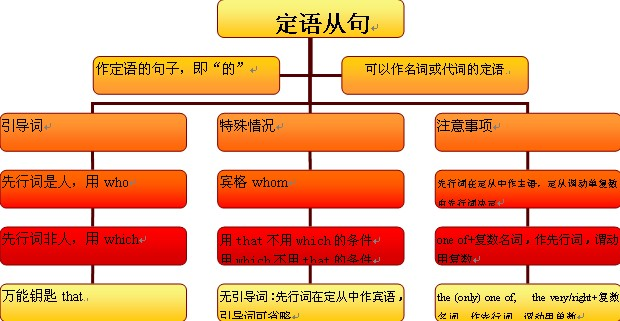
关系代词that的用法:
1)不用that的情况:
a)在引导非限定性定语从句时。
如:(错)The tree, that is four hundred years old, is very famous here.
b)介词后不能用:
如:We depend on the land from which we get our food.
We depend on the land that/which we get our food from.
2)只能用that作为定语从句的关系代词的情况
a)在there be句型中,只用that,不用which。
b)在不定代词,如:anything, nothing, the one, all, much, few, any, little等作先行词时,只用that,不用which。
c)先行词有the only, the very修饰时,只用that。
d)先行词为序数词、数词、形容词最高级时,只用that。.
e)先行词既有人,又有物时。
例:All that is needed is a supply of oil. 所需的只是供油问题。
Finally, the thief handed everything that he had stolen to the police. 那贼最终把偷的全部东西交给了警察。
there be句型的概念:
英语中的there be结构主要表示某处存在有某物,所以通常被称为存在句。其中的there为引导词,无词义,be为谓语动词,therebe后面的名词为句子主语。
therebe结构的否定式和疑问式:
1、否定式:
there be结构的否定式通常应将否定词置于动词be之后:
如:There is not any bread left. 没有一点面包了。
There isn't anything I can do for you. 我帮不了你什么忙。
若谓语中包括有助动词或情态动词,通常将否定词置于助动词与情态动词之后:
如:There can't be so many mistakes. 不可能有那么多错误。
There shouldn't be any doubt about it. 对此不应有什么怀疑。
There haven't been any parties in weeks. 好几个礼拜没开过晚会了。
另外注意以下类型的否定式:
如:There doesn't seem to have been any difficulty over the money question. 在钱的问题上似乎没发生什么困难。
2、疑问式:
there be结构的疑问式通常应将否定词置于动词be之后:
如:Is there any good film on? 映什么好电影吗?
Is there room for me in the car? 车子里还有我坐的地方吗?
Are there any letters for me? 有我的信吗?
若谓语中包括有助动词或情态动词,通常将助动词或情态动词移至句首构成疑问式:
如:Has there been an accident? 出事了吗?
Have there been any new developments? 有什么新的发展吗?
Can there have been so much rain there?那儿会下过那么多雨吗?
另外注意以下类型的疑问式:
如:Uncle Jesse, why do there have to be poor people like those? 杰西叔,为什么一定要有他们那样的穷人?
there be结构的谓语形式:
1、主谓一致问题:
若只有一个主语,谓语的数则取决于该主语的数;若有几个主语并列,则通常是与靠近的主语保持一致:
如:There is a man at the door. 门口有个人。
There are some girls in the room. 房间里有几个女孩。
There is a pen and some books on the desk. 桌上有一支钢笔和一些书。
2、时态问题:
there be结构的时态由其中的谓语动词be来体现,它可以有一般现在时、一般将来时、一般过去时、现在完成时以及过去完成时等多种时态形式:
如:There is going to be[will be] an English film tonight. 今晚将有一场英语电影。
There was a lot to be done. 有很多事要做。
There were some children swimming in the river. 有些小孩在河里游泳。
There have been many such accidents. 已发生了好几起那样的事故。
There had been two seafights between them. 他们之间发生了两场海战。
3、与情态动词连用:
there be结构有时可以与情态动词连用:
如:There may be a storm tomorrow. 明天可能有风暴。
There used to be a hospital here. 原来这里有家医院。
He felt there must be something wrong. 他感到准有什么问题。
There might still be hope. 可能还有希望。
There ought to be a comma here. 这儿应有一个逗号。
4、动词be换成其他动词:
有时可将there be中的动词:be换为live, remain, seem, appear, exist, stand, lie, come等:
如:Once upon a time there lived a man known by the name of Joe Beef. 从前有个人名叫乔·比夫。
There seems[appears] something the matter with her. 她好像是出了什么事似的。
There existed different opinions on this problem. 对这个问题曾有不同看法。
There remained just twenty-eight pounds. 只剩28英镑了。
At the top of the hill there stands an old temple. 在小山顶上有一座古庙。
5、与其他动词搭配使用:
there be结构有时可与其他动词搭配使用,构成一种复合谓语:
如:There seemed to be nobody about, so I went in. 附近似乎没有人,因此我就走了进去。
There happened to be a man walking by. 恰好有一个人从旁经过。
therebe结构的非谓语形式:
基本结构:there be结构的非谓语形式有两种基本结构,即there being和there to be:
1、there being结构该结构的主要用法有:
(1)用作状语:
如:There being nothing else to do, we went home. 由于没什么其他的事要干,所以我们就回家了。
There having been no rain, the ground was dry. 由于没有下雨,所以地面很干。
【注】有时可与状语从句转换:
如:There being no further business(=As there was no further business), I declared the meeting closed. 由于没有别的事了,我宣布闭会。
(2)用作介词宾语:
如:There is now some hope of there being a settle ment of the dispute. 现在有点希望可以解决这次争端。
2、There to be结构该结构的主要用法有:
(1)用作动词宾语:该结构可用作某些动词(如like, prefer, hate, want, mean, intend, expect, consider等)的宾语:
如:I don't want there to be any misunderstanding. 我可不希望有任何误解。
Students hate there to be too much homework. 学生讨厌做太多的家庭作业。
We expect there to be more discussion about this. 我们期望能对此展开更多的讨论。
【注】在let there be结构中,动词be不带to:
如:Don't let there be any noise. 不允许有任何吵闹。
Let there be no mistake about it. 这事不要出错。
(2)用作介词for的宾语:
如:They asked for there to be another meeting. 他们要求再开一次会议。
【注】用作介词宾语一般用there being,但用作介词for的宾语时,只能用there to be。
比较:They planned on there being another meeting. 他们打算再开一次会议。
They planned for there to be another meeting. 他们打算再开一次会议。
几个重要句型和结构:
1、There is no doing结构:
其意为“不可能…”、“无法…”:
如:There's no denying the fact. 这一事实不容否认。
There is no getting over the difficulty. 这困难无法克服。
There is no knowing what he will do next. 无法知道他下一步要干什么。
There was no telling when she would be back. 没法知道她什么时候回来。
2、There is no difficulty in doing sth结构:
意为“做某事没有困难”:
如:There is no difficulty in finding his office. 找到了他的办公室没费一点劲。
There was no difficulty in carrying out the plan. 执行这项计划没什么困难。
3、There's no doubt…结构:
意为“毫无疑问…”:
如:There is no doubt of his success. 毫无疑问他一定会成功。
There could be no doubt that he was one of the best writer in this country. 毫无疑问他是这个国家最优秀的作家之一。
4、There is no hurry(to do sth)句式:
其意为“不用急(于做某事)”:
如:There's no hurry to return the book. 现在不急于还书。
There's no hurry, so do it slowly and carefully. 不用赶时间,要慢慢细心地做。
5、There's no need for…结构:
其意为“不需要或不必要…”:
如:There is no need for help. 不需要帮助。
There is no need for you to go. 你没有必要去。
6、There is no question about...结构:
其意为“…是毫无疑问的”:
如:There's no question about his success. 毫无疑问他会成功。
There's no question about his honesty. 毫无疑问他是诚实的。
7、There is no question of doing sth句式:
其意为“做某事是不可能的”:
如:There is no question of his coming. 他不可能会来。
There is no question of our arriving on time. 我们不可能准时赶到。
8、There is no sense in doing sth结构:
意为“做某事没有道理或好处”:
如:There's no sense in criticizing him. 批评他也没有用。
There's no sense in waiting three hours. 等三小时是不没有道理的。
9、There's no point in doing sth句式:
意为“做某事没有用”:
如:There's no point(in) telling her about it. 告诉她没有用。
如:There's no point in wasting time. 耗时间没用。
【注】以上有的结构中的no根据情况也可换成其他限定词:
如:There is some difficulty in doing sth 意为“做某事有些困难”。
There is much difficulty in doing sth 意为“做某事许多困难”。
There's a need for… 意为“需要或有必要…”。
10、“there be+名词+动词”结构:
(1)there be+宾语+现在分词现在分词表示主动关系,同时表示动作正在进行:
如:There is some one waiting for him. 有人在等他。
There was a man standing in front of me. 我前面站着一个男人。
There were some children swimming in the river. 有些小孩在河里游泳。
There were a group of young people working in the fields. 有一群青年在地里劳动。
有时现在分词可表示一种状态:
如:There's a piano standing against the wall. 靠墙有一架钢琴。
There're a lot of difficulties facing us. 我们面前有很多困难。
There is a door leading to the garden. 有一座门通往花园。
有个别现在分词用于该结构时可以表示将来(正如它们可用进行时表示将来一样):
如:There are ten people coming to dinner. 有10个人来吃晚饭。
(2)there be+宾语+过去分词过去分词表示一种被动关系,同时表示动作已经发生:
如:There is nothing written on it. 上面没写东西。
There were ten people killed in the accident. 事故中有10人丧生。有时过去分词也可表示一种状态(可转换成被动结构):
There were some old men seated(=who were seated)in the back. 有些老人坐在后面。
There is a red car parked(=which is parked)outside the house. 房子外边停着一辆红色汽车。
(3)therebe+宾语+不定式不定式通常表示动作尚未发生:
如:There was nobody to look after the child. 没有人照顾这孩子。
There was a large crowd to send him off. 有一大群人要来给他送行。
There was so much to lose that we couldn't take any risks. 可能会有很大的损失,因此我们不能冒险。
【注】当其中的宾语与其后的不定式为被动关系时,可用主动表被动,也可用被动式:
如:There is much work to do[to be done]. 有许多工作要做。有时其中的不定式为系表结构:
There is nothing to be afraid of. 没什么可怕的。
What was there to be afraid of. 有什么可怕的?
There's nothing to be ashamed of. 没有什么值得羞愧的。
与“短文改错假定英语课上老师要求同桌之间交换修改作文,请你修...”考查相似的试题有:
- The filmHerowas________great success, bringing in a lot of money to________cinema.[ ]A. /; theB. a; theC. /; /D. a; /
- . Let’s take _____ ten-minute break and have _______ drink of water.A.a; aB.the; theC.the; aD.不填;the
- All but_______ going to spend the holiday in the country.A.him and I areB.I and he isC.him and me amD.he and I are
- The most important thing _____ we should consider is the first idea ____ he has talked about in the speech.[ ]A. whic...
- 64. The price of the portable computers(手提电脑) is still so that I can’t afford to buy one.A.highB.lowC.expensiv...
- She is _______ at her boyfriend.A.disappointedB.disappointingC.disappointD.to be disappointed
- If he fails again, he will drag us all ________ with him.
- -----I _____without your help. I do appreciate it .-----You are welcome.A.can’t manageB.couldn’t manageC.can’t hav...
- “It gives me great joy and I feel more pressure than I did _______ I won in China,” Ding Junhui said.A.thatB.when ...
- We’ll never forget the days ______ we spent in the country.A.whenB.whereC.whatD.不填